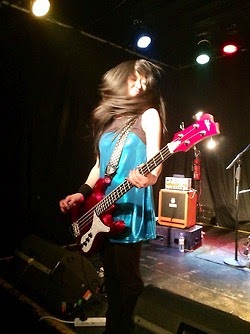The year is 1987. Motorcycle ninjas
tighten their grip on Florida's narcotics trade, viciously annihilating anyone
who dares move in on their turf. Multi-national martial arts rock band Dragon
Sound have had enough, and embark on a roundhouse wreck-wave of crime-crushing
justice.
And that,
according to www.miamiconnection.org, is the plot of one of the greatest
best-worst movies ever made. However
after watching the film myself, shown last week on the roof of the Oh Yeah
Music Centre, I’m not sure I noticed too much of that plot in action. I’m not entirely sure what I saw – I just
know it was awesome.
First of
all, the bad guys in this movie are motorcycle ninjas. Have you even heard of motorcycle ninjas
before? Have you? Of course you haven’t. It’s ridiculous. It’s genius!
I mean, even ninjas face transportation problems – especially ones who
deal in “stupid cocaine”. Do you think
they’re going to drive a battered Ford Fiesta?
You’re a fool. They’re going to
drive motorcycles.
As for the
good guys, they’re a martial arts rock band called Dragon Sound. A multi-national martial arts rock band. Consisting of five orphaned men. Who are also college students. Who live together. And constantly walk around their house half
naked. Enough said. Well, I say rock band...they mainly seem to
sing good natured synth pop songs about being friends forever while performing
tae kwon do on stage. You know you would go to that gig.
And,
hey! It turns out our heroes aren’t all
orphans! One of the gang, Jim
(Maurice Smith), discovers – and here’s a great big spoiler warning, film fans
– that his father (“a black American”) is still alive! While the rest of Dragon Sound are initially
disappointed to learn their orphan connection has been broken, they eventually
share in Jim’s squealing happiness,
hoisting him aloft on their shoulders, all shirtless as usual. It’s a beautiful thing.
In amongst
the touching male bonding, though, we get several action packed tae kwon do
scenes to enjoy. I was particularly
impressed with a montage in which Mark (played by writer/actor/tae kwon do
expert/motivational speaker Y.K. Kim) demonstrated how the humble foot can be
used as a deadly method of martial arts face control. Or something.
The tae kwon
do scenes get more ridiculous as the film progresses, and by the end band
member John (Vincent Hirsch) is basically just running around a park with his
shirt off, covered in the blood of his enemies and screaming. It’s rousing stuff.
If shirtless
men engaging in hand to hand combat doesn’t grab your attention, there is at least a
touching love story for the more sensitive viewers to enjoy. And just like Romeo and Juliet, our young
lovers belong to two rival camps.
The aforementioned John is deeply in love with Jane (Kathy Collier), but
Jane is the sister of Jeff (William Ergle) – and Jeff is the second in command
of the motorcycle ninjas! It’s OK though
– John kills Jeff in battle, and Jane is refreshingly cool with this. This may
not be exact dialogue from the film, but their deep and meaningful talk
about the killing basically goes like this:
John: “Yeah, sorry about killing your brother and
stuff”
Jane: “Whatevs”
And then
they kiss, while Jim leers over them thinking about his daddy.
There’s just
so much going on in Miami Connection, I couldn’t possibly blog about it
all. I mean, I haven’t even touched upon
the scene in which another band member hilariously sexually harasses bikini
clad strangers on the beach. Or the
scene in which Mark playfully force feeds grapes to his still half naked house
mates. And who could forget the touching
scene where Jim buys a new suit in which to meet his long lost daddy, his
friends in the changing room with him, caressing his new threads lovingly and
calling them “beautiful”?
If I haven’t
sold you on this film by now, there is no hope.
All I can do is leave you with the same powerful message Miami
Connection leaves its viewers with, and trust you all to do the right thing. Love your friends, listen to synth pop, and
stay away from stupid cocaine. Peace,
guys.
























